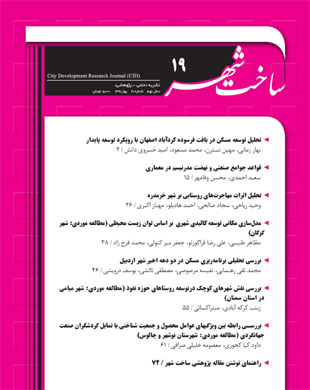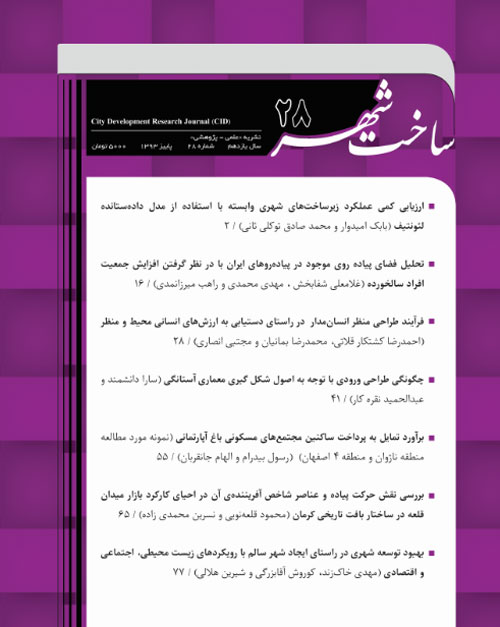فهرست مطالب

فصلنامه ساخت شهر
پیاپی 19 (بهار 1391)
- تاریخ انتشار: 1391/04/04
- تعداد عناوین: 7
-
-
Page 2Housing is the primary and basic need of all human beings since the beginning of the creation. Today, increasing population and rapid urbanization growth have caused increasing housing demand. This issue has led to the unlimited horizontal growth of the cities and the destructive development of them in the suburban areas. The illogical expansion of Isfahan during the recent decades resulted in the joint of scattered contexts of the suburbs to urban areas and consequently, it led to the increasing growth of immigration. This issue not only led to the housing shortage problem, but also made such contexts to move toward a fake growth and unsustainable development. Deteriorated context of Kerdabad is a sample of such context which is located in the eastern margin of Isfahan and belongs to the municipality zone four. In this research with the aim of housing development analysis, approaching sustainable development in deteriorated context of Kerdabad, and by the use of analytical-descriptive research method, the status of the area and its residential structure are studied through the economic, social, physical and environmental indicators, and are then analyzed by SWOT technique. Recent surveys show that habitation status in Kerdabad is not towards sustainable development. The high percentage of low-income people, the low quality ofconstructions, the proximity of incompatible land use with residential context, intense shortage of services and trespass on agricultural lands, confirm and substantiate this claim. In continuation of the operational goals, strategies and executive policies are revised and prepared. The results indicate that improving financial ability of the households, standardization of the housing, organization of land uses, and increasing the supervisory role of the municipality on housing development are the most efficient strategies to achieve sustainable development of housing in Kerdabad.Keywords: Housing, Housing indicators, Sustainable development, Deteriorated context, Kerdabad, Swot technique
-
Page 15The rules governing industrial societies refer to the new method of life prior to the industrial revolution that have shaped the foundation of new industrial civilization originated from the intellectual renaissance of the seventeenth century in Europe. The present research aims to identify the effects of new models engendered by such rules in social, cultural, economic, political and architectural fields in industrial communities to help one achieve exact understanding on the origin of Modernism in architecture. The main aim of this research is finding out the reasons of change in the models of the early twentieth century architecture and detection of roots in the origin and commencement of Modernism in architecture. The results of this research are helpful to learn the reasons of success or failure of architecture in communities – particularly developing countries – that are somehow involved with sudden, rapid industrial changes. The present research studies the sextuple rules governing industrial societies in architecture explained by Alvin Toffler in his book entitled ‘The Third Wave’. To realize the effects and outcomes, various books on the history of modern, western architecture, and on the rules of industrial communities, as well as the changes made in them in this era, are surveyed and studied.Keywords: Industrial revolution, Industrial society rules, Architecture, Change of the model, The Movement of Modernism
-
Page 26Rural migration not only leaves fundamental effects on the target habitats, but also causes drastic change on the structure of the source villages. The city of Khoramdarreh witnessed some changes on the price of land, destruction of the surrounding farming lands, and on the formation of the margin and boundaries. It seems that the main reason of such changes is the immigration of villagers from the suburban areas to the city. In the present research, all data and information are collected through the library documents, questionnaire, field study and interview. The main aim of the research is the detection and analysis of the consequences of the rural migration to the city of Khoramdarreh. The statistical society of the present research is the population of Khoramdarreh, and the sampling method is the simple systematic sampling from the central and suburban districts. This research is based on analytic–descriptive method that studies population changes, the price of land, and urban physical development as the main consequences of rural migration. Statistical method is used for the analysis of data and the urban status during the last few years of the period. The results of the study reveal that there is a direct relationship between people's immigration from the surrounding villages of Khoramdarreh to the city of Khoramdarreh. Secondly, there is a close relationship between people's immigration and urban structural changes such as, urban physical development, destruction of farming lands, formation of new urban spaces, development of the margin, and consequently, unreasonable increase in the price of lands.Keywords: Urban, rural immigration, Price of land, Change of farming land's usage, Margin, boundaries, the City of Khoramdarreh
-
Page 38Urban structural development is an inevitable procedure caused by many factors, the consequence ofwhich differs in various locations. To avoid any further problems caused by urban structural development, it seems indispensible to control the development and follow it based on scientific principles. Definitely, unscientific urban growth leaves undesirable effects such as, overcrowding in certain parts of the city, more traffic jam, destruction of farming lands in the suburbs, environmental damage, decrease of urban facilities and services. To minimize the problems caused by urban structural development, certain factors such as, slope, slope direction, height, land usage should be involved in urban development. Moreover, a method should be used to be able to engage factors that are influential in urban development based on their level of significance. Nowadays, the application of GIS is increasing widely in all dimensions, so much so that it is considered and used as an important and capable mean in saving or storage, marketing, and data analysis. Definitely, it is an important need to have access to information and records that function as the main factors in designing, making decision, usage, supervision and construction of different projects. GIS can be used appropriately in this regard. In this research it is aimed to identify suitable places for development by GIS, priority of identified locations, and the hierarchical analysis of the regions potentially capable for development. To achieve such an aim, effective factors in urban development should be identified first, and secondly, they should be changed to GIS maps. To select the best region and the priority of them, influential factors in urban structural development are compared with each other based on their level of significance and by the use of AHP hierarchical analysis. Finally, suitable areas for development will be identified according to the priority basis and by the use of GIS analytical functions.Keywords: GIS, AHP, Overlay, Consistency
-
Page 46To study the present status of urban accommodation is one of the most significant factors in accommodation planning. Definitely, lack of knowledge and accurate assessment on present accommodation status, planning as well as ambiguities in goals, policies and approaches will face one with numerous problems. Social and economic conditions of Ardabil are changed drastically during the past two decades, and have consequently, caused problems in accommodation under the scrutiny of the present research. The questions raised in the field of accommodation include the present status of housing and its relevant issues in Ardabil, quantitative and physical status of them, Ardabil’s social structural conditions, the population of each family, rental fees, residential usage, and the conditions of old and new urban tissues. The present research aims to provide reasonable answers for the above-mentioned questions and puts forward suggestions for the improvement of the accommodation status to help remove problems of Ardabil. This improvement is achieved through understanding the issues pertaining to the case study, and through the analysis of information with due consideration to other regional changes influential in accommodation planning.Keywords: Accommodation, Residential unit, Family population, Residential usage
-
Page 55
Paying close attention to the infrastructure and developmental facilities of towns is one of the most essential and primitive actions regarding the reinforcement and improvement of living conditions in small towns to make them more attractive. Lack of attention to such issues results in the lack of output or financial justification for investment. The present research aims to answer these questions that whether or not small towns as Miami, regarded as the initial nucleolus, have any role in the fixation of population, employment, and facilities of the region under scrutiny. Therefore, Miami as a small town converted to a city in 1994 will be studied in this research conducted by descriptive-analytical method. It studies the role of a small town as Miami, located in the surroundings of Shahrood in Semnan province, in the development of the predominated villages. The results of the analysis indicate that this city succeeded to control migratory changes through making an appropriate policy and urban development, relative fixation of population on predominated areas, providing job opportunities, services and facilities. The results also denote that such small towns, regarded as agricultural poles of the region, can potentially increase their population if they are duly supported and developed. Being located on the rural migration route, such cities can direct the migratory flow to themselves and other nearby community centers. Considering the potentials and capacities of Miami and its mutual interaction with surrounding towns and villages, some suggestions are put forward regarding the establishment of industries for production purposes. This will enable the fore-cited city to play more significant role not only in infrastructural affairs, but also in the extension of functions and controlling the immigrants’ population, and in the expansion of fundamental and productive affairs.
Keywords: Regional role of the city, Small town, City of Miami, Rural development, Predominated areas, Immigration -
Page 61Tourism industry is potentially capable of putting significant effects on increasing occupation, income pertaining to residential locations, as well as having influence on the state income of a country. Therefore, tourism influences economic growth both directly and indirectly that in turn, it leads to the growth of tourism industry. The aim of this article turns round studying on the relationship between product factors (including attractions, facilities, and infrastructures) and variables of demography (including the level of literacy, the method of selecting the destination, the length of time of residence, occupation and gender) with due regard to the inclination of tourists to two cities, namely Noushahr & Chalous.MethodologyThe statistical society of the research is the tourists who travelled to these two cities during the summer 2010. 352 people were chosen through random sampling and were given the questionnaire. The type of research is based on the applied target and is carried out according to the descriptive-solidarity method. The method of field data collection is based on library, internet sites, and questionnaire scrutinized and analyzed through descriptive statistics (the calculation of abundance percentage, the percentage of density abundance, average standard deviation, tables and diagrams) and deductive statistics (Pearson correlation Test, multi-variable linear regression, step-by-step regression, one-sided variance analysis, T-test for two independent groups and using SPSS software).Results And DiscussionAll assumptions out of eight sub-hypothesis have been approved. As the deduction and conclusion at the final part of the article, some comments have been adduced regarding the application of the fore-cited results in our real world as well as pursuing similar researches in future.Keywords: Tourism industry, Product factor, Demography, Tourist's inclination, Noushar, Chalous, Descriptive method, Questionnaire, Reliability, Deductive statistics


